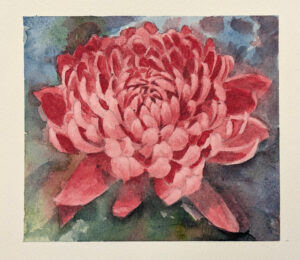
In the Northern Hemisphere, November is the last month of Autumn – the longer, warmer summer days are past, and the winter is on the horizon, a time for nature to adapt, recuperate, reset, slow down and prepare for the spring.
November gets its name from the Latin “novem,” meaning nine, as it was originally the ninth month in the early Roman calendar. After the calendar switched to 12 months in 154 BCE, it became the eleventh month. In Anglo-Saxon times, November was known as “Wind Monath” (Wind Month) and “Blod Monath” (Blood Month), referring to the strengthening winds and the preparation of meat for winter storage.
Across the world, November is a time for reflection and celebration.
When thinking about the colours of November, three immediately stood out to me: crimson, indigo, and gold.
 Crimson evokes late autumn flowers, fallen leaves, and the vibrant hues of autumn sunsets. The Chrysanthemum, November’s birth flower, is often crimson and represents cheerfulness across cultures. Derived from the Kermes insect, the crimson dye has been used since ancient times and is associated with royalty and power. British officers once wore crimson uniforms, and today, the King’s Royal Hussars continue the tradition with crimson trousers.
Crimson evokes late autumn flowers, fallen leaves, and the vibrant hues of autumn sunsets. The Chrysanthemum, November’s birth flower, is often crimson and represents cheerfulness across cultures. Derived from the Kermes insect, the crimson dye has been used since ancient times and is associated with royalty and power. British officers once wore crimson uniforms, and today, the King’s Royal Hussars continue the tradition with crimson trousers.
Alizarin Crimson, synthesised in the 19th century, became popular among artists, providing a deep, blue-red hue. Winsor & Newton introduced it to their watercolour range in 1891, though its lightfastness has been a concern, leading to modern alternatives.
Indigo, a deep, dark blue, sits between dark purple and dark blue on the colour spectrum. It perfectly reflects the cold November nights, when the sky darkens just after sunset and the stars begin to peek through. During these longer nights, you might catch a glimpse of cosmic events like the Leonid meteor shower, which peaks on the 17th-18th of November. It’s also the time to witness mesmerising starling murmurations as the birds flock together in synchronised patterns against the indigo sky, just before the light fades entirely.
Historically, indigo has been highly prized as a fabric dye. Extracted from the leaves of the Indigofera plant, it was used for thousands of years in Asia, Africa, and South America. Its rarity made it a valuable trading commodity, often referred to as “blue gold.” In Europe, indigo remained rare until the 17th century, when it replaced woad as the main source of blue dye.
Synthetic indigo was developed in 1867 by chemist Adolf von Baeyer, revolutionising the industry and making this colour more accessible. Indigo remains a popular pigment today, its deep, rich hue symbolising the transition into winter.
 The lyrics in the Bob Schneider song “Gold in the sunset” completely sum up why I have chosen Gold as the third colour of November:
The lyrics in the Bob Schneider song “Gold in the sunset” completely sum up why I have chosen Gold as the third colour of November:
“All the gold in the sunset all the diamonds on the sea ,
All the gold in the sunsets all I’ll ever need,
All the gold in the sunset all the diamonds in the sea ,
It’s all we need to set ourselves free
Gold, like the glowing light of a November sunset, represents warmth as the days cool. November’s birthstones, Topaz and Citrine, shimmer in golden hues and are thought to possess calming energies. Gold has been revered throughout history, used in Egyptian jewellery, Islamic manuscripts, and South American temples. It remains a symbol of luxury, often appearing in art and jewellery today. Gold leaf, used in painting and gilding, continues to add a touch of splendour to modern artwork. The ancient Japanese art of Kintsugi, where broken pottery is repaired with gold, embodies the beauty of imperfection and resilience.
The end of November turns into December, the last month of the year and a busy month with the advent and preparation for the Christmas period. So it is a chance to take the time to take things more slowly and appreciate the colours which surround you and how they change from month to month.